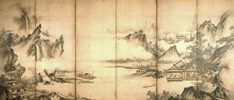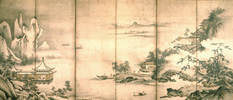David Henry Hwang
Though the screens
are from Japan, the artist has appropriated Chinese styles of landscape
painting, which would've been considered very chic. Yet the execution
of this typically Chinese subject incorporates distinctly Japanese visual
elements, including flatness and an almost graphic quality. Moreover,
the work was painted at a time when this style was already considered
dated within China itself. They might therefore be considered neither
"authentically" Chinese nor Japanese. Interestingly, however, painting
techniques such as these were eventually incorporated into the mainstream
of Japanese art. The screens therefore remind me of contemporary cross-cultural
work, in which traditional mythologies and icons are sometimes reinterpreted
through modern sensibilities, resulting in pieces which might be considered
"incorrect" in strict anthropological or historical terms, but which may
nonetheless show artistic merit.
Pico Iyer
If someone were to
ask me why I choose to live in Asia, I would point her to these screens:
the absences at their center, the mist, the indefinable sense of sadness
at their heart. Looking closely, I see that the landscapes are richly
populated; and yet all the figures are tiny, inconsequential almost, in
the context of the larger pattern, and at their center is an emptiness-a
cloud, a mystery-that I can still believe to be the heart of East Asian
cultures today.
In Oriental art, I
am reminded, the subject of a painting may be what is left out; and people
leave themselves out, often, so that a feeling-as here of wistfulness,
or melancholy-becomes much stronger than the press of personality. The
individual recedes before the passing of the seasons, and in these paintings
I feel I can see an affirmation of the moment in the face of (and not
smudged by) the fact that moments always pass. A joyful participation,
as the Buddhists say, in a world of sorrows.
When first I went
to live in Japan, in 1987, I found that no religion was observed more
ceremoniously, or more selflessly, than the seasons; in life as on the
canvas, people disappear inside a scene as if not to smudge it with themselves.
I look here at the figures turning around a corner, I see a lonely spire
poking through the mist, I imagine a bird's distant cry and I feel as
if something is calling to me from the next valley over but one.
Malavika Sarukkai
Two
six-paneled screens that may be seen together, or folded to contemplate
one season at a time compressing functionality with artistry. A river winds
through the four landscapes, each sharp with the season's flavor, each depicting
the benevolence of nature. Each season is linked to the next, and the human
within it links with nature. These superbly reflective screens mirror beauty
and harmony. Human dwellings nestle in mountainous crags and riverfronts,
reflecting the same tones in color and emotion, suggesting merging, cyclicity,
hope…
|

